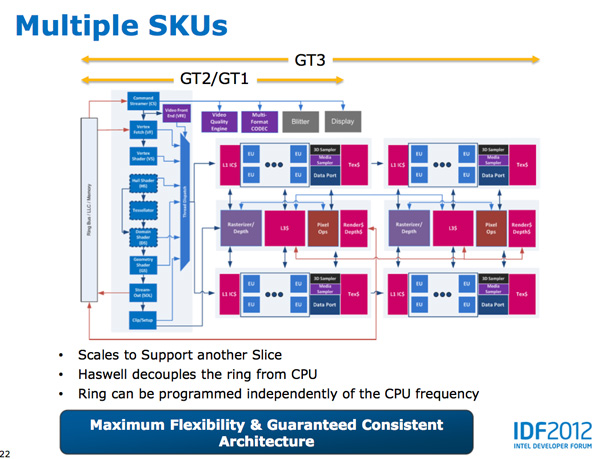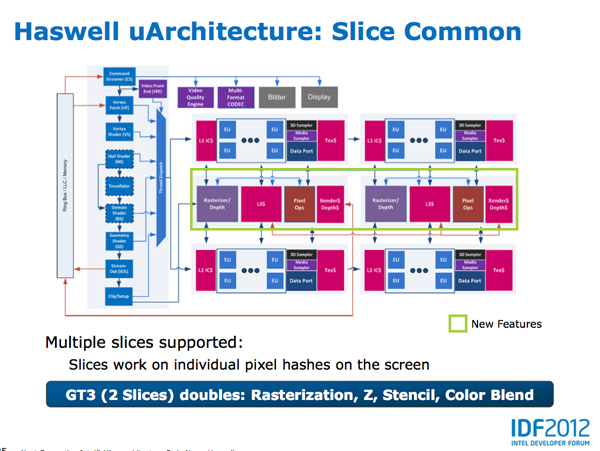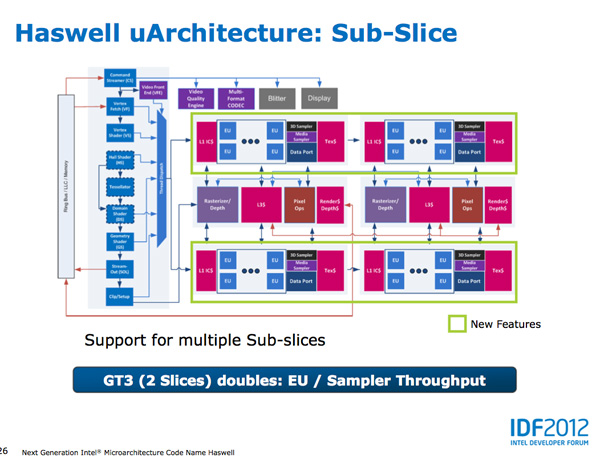Intel's Haswell Architecture Analyzed: Building a New PC and a New Intel
by Anand Lal Shimpi on October 5, 2012 2:45 AM ESTHaswell's GPU
Although Intel provided a good amount of detail on the CPU enhancements to Haswell, the graphics discussion at IDF was fairly limited. That being said, there's still some to talk about here.
Haswell builds on the same fundamental GPU architecture we saw in Ivy Bridge. We won't see a dramatic redesign/re-plumbing of the graphics hardware until Broadwell in 2014 (that one is going to be a big one).
Haswell's GPU will be available in three physical configurations: GT1, GT2 and GT3. Although Intel mentioned that the Haswell GT3 config would have twice the shader count of Haswell GT2, it was careful not to disclose the total number of EUs in any of the versions. Based on the information we have at this point, GT3 should be a 40 EU configuration while GT2 should feature 20 EUs. Intel will also be including up to one redundant EU to deal with the case where there's a defect in an EU in the array. This isn't an uncommon practice, but it does indicate just how much of the die will be dedicated to graphics in Haswell. The larger of an area the GPU covers, the greater the likelihood that you'll see unrecoverable defects in the GPU. Redundancy at the EU level is one way of mitigating that problem.
Haswell's processor graphics extends API support to DirectX 11.1, OpenCL 1.2 and OpenGL 4.0.
At the front of the graphics pipeline is a new resource streamer. The RS offloads some driver work that the CPU would normally handle and moves it to GPU hardware instead. Both AMD and NVIDIA have significant command processors so this doesn't appear to be an Intel advantage although the devil is in the (unshared) details. The point from Intel's perspective is that any amount of processing it can shift away from general purpose CPU hardware and onto the GPU can save power (CPU cores go to sleep while the RS/CS do their job).
Beyond the resource streamer, most of the fixed function graphics hardware sees a doubling of performance in Haswell.
At the shader core level, Intel separates the GPU design into two sections: slice common and sub-slice. Slice common includes the rasterizer, pixel back end and GPU L3 cache. The sub-slice includes all of the EUs, instruction caches and EUs.
In Haswell GT1 and GT2 there's a single slice common, while GT3 sees a doubling of slice common. GT3 similarly has two sub-slices, although once again Intel isn't talking specifics about EU counts or clock speeds between GT1/2/3.
The final bit of detail Intel gave out about Haswell's GPU is the texture sampler sees up to a 4x improvement in throughput over Ivy Bridge in some modes.
Now to the things that Intel didn't let loose at IDF. Although originally an option for Ivy Bridge (but higher ups at Intel killed plans for it) was a GT3 part with some form of embedded DRAM. Rumor has it that Apple was the only customer who really demanded it at the time, and Intel wasn't willing to build a SKU just for Apple.
Haswell will do what Ivy Bridge didn't. You'll see a version of Haswell with up to 128MB of embedded DRAM, with a lot of bandwidth available between it and the core. Both the CPU and GPU will be able to access this embedded DRAM, although there are obvious implications for graphics.
Overall performance gains should be about 2x for GT3 (presumably with eDRAM) over HD 4000 in a high TDP part. In Ultrabooks those gains will be limited to around 30% max given the strict power limits.
As for why Intel isn't talking about embedded DRAM on Haswell, your guess is as good as mine. The likely release timeframe for Haswell is close to June 2013, there's still tons of time between now and then. It looks like Intel still has a desire to remain quiet on some fronts.














245 Comments
View All Comments
Peanutsrevenge - Friday, October 5, 2012 - link
What the hell are you guys bitching about?Of course the iPhone articles are going to be longer and more numerous than GS3 articles.
iPhone releases come with new iOS releases and have their own eco-system.
Android phone releases use a common OS across them and therefore much of what's in one article doesn't need repeating in another.
Anand liking Apple is not our problem, I can see why people like them (not so much Anand) and that's fine, personally I dislike them (hate was originally typed, but was edited due to being incorrect), but still respect them and respect people who purchase their products (and pay for their litigation).
An entire page of comments talking about how Anand isn't allowed to like or talk about Apple products because you guys don't like is ridiculous, they're a PC company and should exist on a PC website.
Grow up.
Kepe - Friday, October 5, 2012 - link
Sure, but I'm talking about dedicating entire, long articles to such things as the iPhone display or why it doesn't have a certain feature and so on. The SGS III has a very interesting display, too. Still it didn't get nearly as much attention. Of course Anand is allowed to talk about Apple products. What I want, though, is Anand(tech) to be as thorough in reviewing other products, too, or then stop making those huge articles only about Apple products. Because that is biased.In the Macbook Pro Retina article Anand talked about the cooling system and the fan blades for one page. When I read any other laptop review on Anandtech, cooling is briefly described in a sentence or two.
Dedicating so much attention to just one company's products makes it look like Anandtech is biased. And that is not good.
Magik_Breezy - Sunday, October 14, 2012 - link
Hopefully because of these comments they'll finally see what we want, not some Apple crap. Good engineering stupid managementSpunjji - Thursday, October 18, 2012 - link
Nailed it.vFunct - Saturday, October 6, 2012 - link
Android products would get more coverage if they bothered to do any engineering on them. Since they don't push the technology the way Apple does, they don't need a more in-depth review.StevoLincolnite - Saturday, October 6, 2012 - link
You're kidding right? Hardware wise Apple has always been behind the curve compared to the competition in every facet of it's product line-ups or very quickly beaten.lmcd - Saturday, October 6, 2012 - link
Umm, I would disagree there. Apple has always been ahead of the curve in GPUs and this is the FIRST TIME SINCE BEFORE THE A-SERIES that Apple has had a GPU without an overwhelming lead on the competition for more than half a year.*While GPU selection isn't always huge, it's one of the biggest points of differentiation in mobile chips, along with power use.
*excluding the A4 if you count from when it was first in a phone as opposed to in a tablet.
Magik_Breezy - Sunday, October 14, 2012 - link
The last time I played a game on my phone was about 8 months ago and I'm 15! To say that Apple pushes their hardware is naive as it gets.The Galaxy S III was the best purchase Ive made, even my mum doesn't like my iPhone 4.
vFunct - Sunday, October 7, 2012 - link
Yes, Apple products are always ahead of compromised Android products.Android devices are badly engineered, like incorporating LTE when the battery can't handle it, for example. Apple doesn't compromise on their design.
Kepe - Monday, October 8, 2012 - link
How much does Apple pay you for a comment praising them?